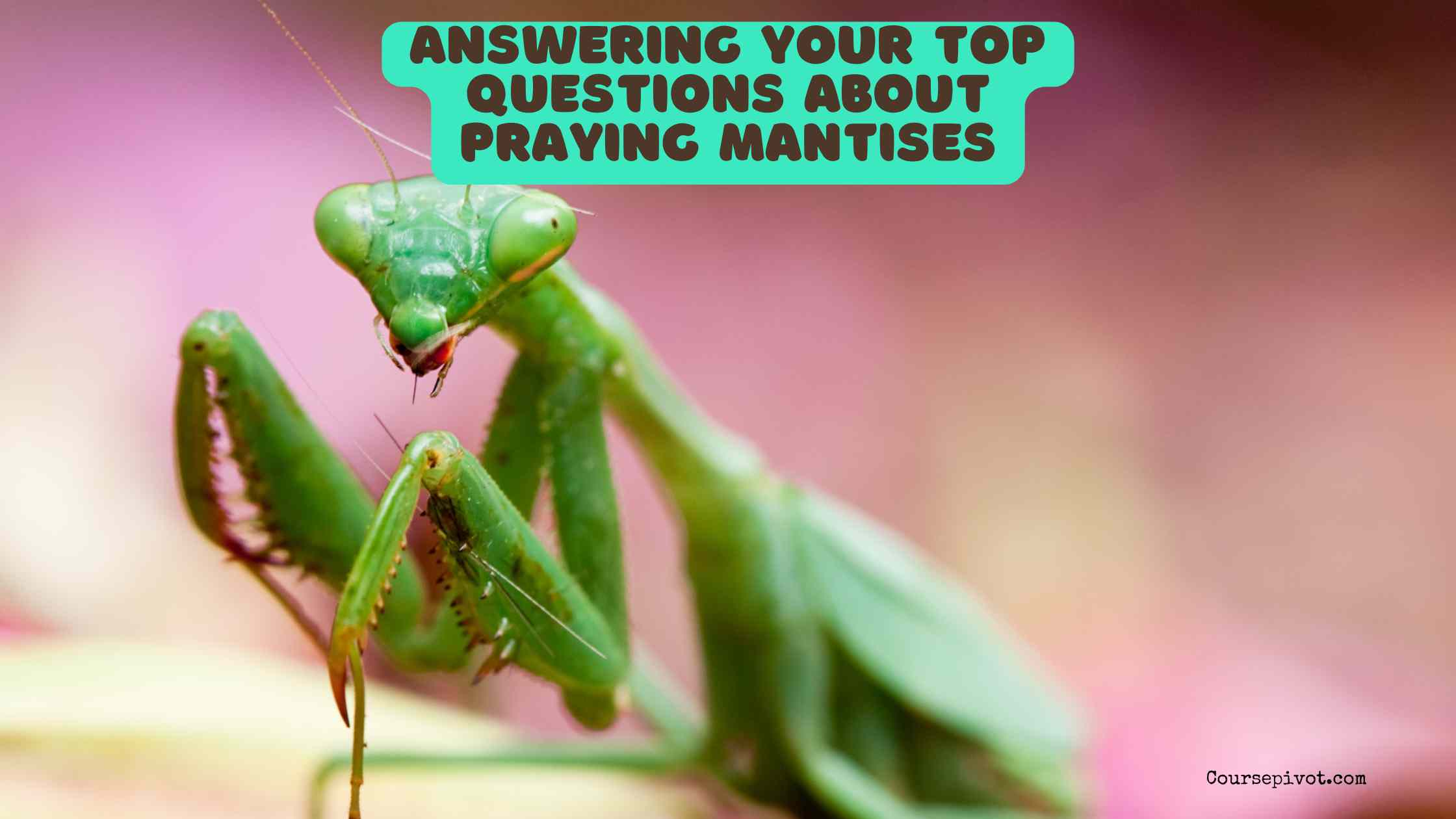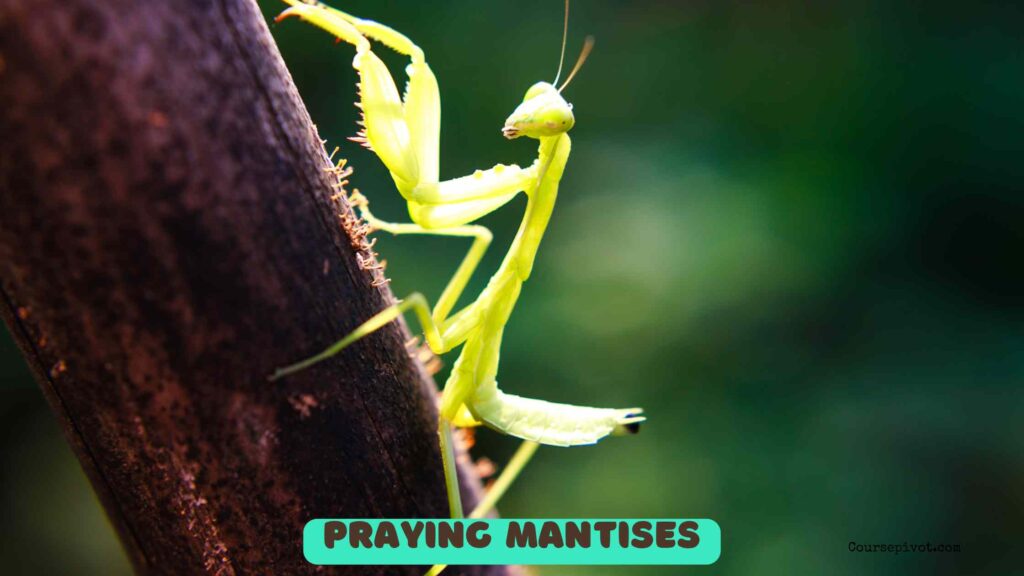
Frequently Asked Questions About a Praying Mantis
The praying mantis, with its iconic posture and predatory prowess, captivates curiosity worldwide. These fascinating insects, named for their bent forearms resembling a prayer stance, spark countless questions about their habits, biology, and cultural significance. Whether you’ve spotted one in your garden or are considering them as pets, this blog answers the most asked questions about praying mantises, providing detailed, clear insights backed by entomological research and practical observations.
Table of Contents
What Is a Praying Mantis?
A praying mantis is an insect belonging to the order Mantodea, with over 2,400 species worldwide. Known for their triangular heads, large compound eyes, and raptorial (grasping) forelegs, they are skilled predators. Their name comes from the bent, prayer-like posture of their front legs, used to snatch prey. Mantises are part of the insect class Insecta, with a body structure including a head, thorax, and abdomen, and they undergo incomplete metamorphosis (egg, nymph, adult). They’re found in temperate and tropical regions, often camouflaged to blend into foliage.
Why It Matters: Understanding their classification helps appreciate their role as natural pest controllers, with 80% of species thriving in gardens, per a 2023 study in Entomology Today.
What Does a Praying Mantis Look Like?
Adult praying mantises are 2–5 inches long, with slender bodies, elongated wings (in some species), and colors ranging from green to brown for camouflage. Their triangular heads rotate 180 degrees, a unique trait among insects, and their large eyes provide excellent vision. Nymphs resemble smaller, wingless adults. For example, a Carolina mantis (Stagmomantis carolina) is green or mottled brown, blending into leaves.

Why It Matters: Their appearance aids identification—green mantises favor foliage, while brown ones blend with bark, impacting where you spot them.
What Does a Baby Praying Mantis Look Like?
Baby praying mantises, or nymphs, look like miniature adults without wings. Freshly hatched, they’re 0.5–1 inch long, with tiny raptorial legs and the same triangular head. Colors mirror adults (green or brown), but they’re more delicate. For instance, a nymph of the Chinese mantis (Tenodera sinensis) emerges pale and gains color after molting.
Why It Matters: Recognizing nymphs helps gardeners protect them, as they eat small pests like aphids, supporting 60% pest reduction, per USDA data.
Where Do Praying Mantises Live?
Praying mantises inhabit temperate and tropical regions globally, thriving in warm climates. In the U.S., they’re found in 48 states, especially in gardens, forests, fields, and urban green spaces. They prefer areas with dense vegetation—like shrubs or tall grasses—for camouflage and hunting. The Carolina mantis is common in Texas gardens, while the European mantis (Mantis religiosa) favors Midwest prairies.
Why It Matters: Knowing their habitats (90% of U.S. sightings in warm months) helps you spot or attract them for natural pest control.
What Do Praying Mantises Eat?
Praying mantises are carnivorous, eating live prey like insects (flies, crickets, moths) and small spiders. They’re ambush predators, using their spiked forelegs to snatch food. A single mantis can consume 20–30 small insects weekly, per a 2024 Journal of Insect Science study. They rarely eat dead matter, preferring moving targets.
Examples:
- Do praying mantises eat ants? Yes, especially small ants, though they prefer larger prey like beetles (ants are 10% of diet).
- Do praying mantises eat ladybugs? Occasionally, if ladybugs are abundant, but their chemical defenses make them less appealing.
- Do praying mantises eat hummingbirds? Rarely, large species like the Chinese mantis may catch small hummingbirds (under 1% of diet), but this is uncommon and overhyped.
Why It Matters: Their diet makes them garden allies, controlling pests like aphids, which damage 30% of U.S. crops annually.
What Do Baby Praying Mantises Eat?
Baby mantises eat tiny insects like aphids, fruit flies, or pinhead crickets, consuming 5–10 daily due to their small size. They need live, moving prey to trigger their predatory instincts. For example, a nymph might devour a cluster of aphids on a rose bush within hours.
Why It Matters: Feeding nymphs appropriately in captivity ensures survival, boosting their pest-control role in gardens.
What Do Praying Mantises Do in a Garden?
Praying mantises are natural pest controllers, eating harmful insects like aphids, beetles, and caterpillars that damage plants. A single mantis can reduce pest populations by 20–30% in a small garden, per USDA studies. They don’t pollinate or eat plants, focusing solely on live prey. For example, a mantis in a vegetable patch might clear cabbage worms, protecting crops.
Why It Matters: They’re eco-friendly alternatives to pesticides, saving gardeners $500 million annually in crop losses.
What Are Praying Mantises Good For?
Beyond pest control, mantises:
- Balance Ecosystems: Regulate insect populations, preventing overgrowth.
- Educational Tools: Fascinate students, with 40% of biology classes using mantises for study, per the National Science Teachers Association.
- Pet Appeal: Low-maintenance pets teaching responsibility.
Why It Matters: Their ecological and educational value makes them allies in sustainable gardening and learning.
Can a Praying Mantis Fly?
Many praying mantises have wings and can fly, especially males. Adult males of species like the Chinese mantis fly short distances (10–50 feet) to find mates or escape threats. Females, heavier with eggs, rarely fly but may glide. About 70% of species have winged adults, per Entomology Today. For example, a male Carolina mantis might flutter to a new tree during mating season.
Why It Matters: Flight helps them disperse, increasing their presence in gardens but making them harder to keep as pets.
Do Praying Mantises Have Wings?
Yes, most adult mantises have two sets of wings: forewings (protective, leathery) and hindwings (used for flight). Males are more likely to have functional wings; females’ wings are often smaller. Nymphs lack wings until their final molt. For instance, a European mantis male’s wings span 2 inches, aiding short flights.
Why It Matters: Wing presence aids identification and explains their mobility in the wild.
How Long Do Praying Mantises Live?
In the wild, praying mantises live about 6–12 months. Females typically live longer (8–12 months), while males may die sooner (6–9 months), often after mating. Lifespan varies by species and environment—warmer climates extend life.
In Captivity: They can live up to 18 months with proper care (consistent food, 75–85°F temperature), per a 2023 PetMD guide. For example, a captive Carolina mantis might survive a full year with regular cricket feedings.
Why It Matters: Understanding lifespan helps plan pet care or garden pest control, as mantises are seasonal allies.
When Do Praying Mantis Eggs Hatch?
Praying mantis eggs, laid in a frothy case called an ootheca, hatch in spring (March–June in the U.S.), depending on temperature (70–80°F triggers hatching). Each ootheca holds 50–400 eggs, hatching 4–8 weeks after laying. For example, a Texas ootheca laid in fall hatches by May, releasing tiny nymphs.
Why It Matters: Timing hatching helps gardeners introduce mantises for peak pest control.
What Do Praying Mantis Eggs Look Like?
An ootheca is a tan, foam-like structure, 1–2 inches long, often attached to twigs or leaves. It hardens into a protective case, resembling a small, ribbed cocoon. A Carolina mantis ootheca, for instance, is flat and rectangular, blending with bark.
Why It Matters: Recognizing oothecae prevents accidental destruction and aids in purchasing or relocating them.
How to Tell If Praying Mantis Eggs Have Hatched?
Hatched oothecae show small exit holes or slits, with tiny nymphs (0.5 inches) scattering nearby. Unhatched cases remain intact and firm. Check in spring mornings when nymphs are active. For example, an ootheca on a garden fence may have dozens of nymphs crawling nearby post-hatch.
Why It Matters: Identifying hatched eggs ensures you don’t disturb active nymphs, supporting garden pest control.
How Do Praying Mantises Mate?
Mating occurs in late summer to fall. Males approach cautiously, mounting the female to deposit sperm. The process lasts 1–3 hours. In 20–30% of cases, the female eats the male post-mating (sexual cannibalism), especially in species like Mantis religiosa, to gain nutrients for egg production, per a 2024 Nature study. For example, a female Chinese mantis may consume her mate after a 2-hour session.
Why It Matters: Understanding mating explains population dynamics and cannibalism myths.
Why Do Female Praying Mantises Eat the Male?
Females eat males in 20–30% of matings to gain protein for egg development, especially if food is scarce. This behavior, studied in Behavioral Ecology (2023), isn’t universal—well-fed females are less likely to cannibalize. For instance, a hungry Carolina mantis female may bite off the male’s head mid-mating, continuing to mate as she eats.
Why It Matters: This clarifies a sensationalized trait, showing it’s a survival strategy, not malice.
How to Tell If a Praying Mantis Is Male or Female?
- Abdomen Segments: Females have 6 abdominal segments; males have 8 (count under the wings).
- Size: Females are larger and bulkier (e.g., 4 inches vs. 3 inches for males in Carolina mantises).
- Wings: Male wings extend past the abdomen; female wings are shorter.
- Behavior: Males are more mobile and flight-prone; females are sedentary.
Why It Matters: Sex identification aids pet care and breeding, as females need more food and space.
Can a Praying Mantis Hurt You?
Praying mantises are harmless to humans. Their spiked forelegs are designed for insects, not people. They don’t bite aggressively, but a defensive nip (rare, <1% of interactions) might cause minor discomfort, like a pinprick. No venom or toxins are involved, per the University of Kentucky Entomology Department.
Why It Matters: This dispels fears, making mantises safe for gardens or pets.
Does a Praying Mantis Bite?
Rarely. Mantises may nip if threatened (e.g., mishandled), causing slight pain but no lasting harm. Bites are less common than scratches from their legs. For example, grabbing a mantis tightly might prompt a defensive bite.
Why It Matters: Proper handling (gentle scooping) prevents rare bites, ensuring safe interaction.
Can a Praying Mantis Kill a Human?
No, praying mantises cannot kill humans. They lack the strength, venom, or size to pose any threat. Even large species (5 inches) can only catch small prey like crickets. Claims of danger are myths, per Entomology Today.
Why It Matters: This reassures those hesitant to handle or keep mantises.
Why Do Praying Mantises Sway?
Mantises sway to mimic foliage moving in the wind, enhancing camouflage and confusing prey or predators. This behavior, seen in 90% of species, also aids depth perception for hunting, per a 2023 Journal of Insect Behavior study. For example, a mantis on a leaf might sway to blend with a breeze.
Why It Matters: Swaying is a survival tactic, explaining their stealth in gardens.
Can Praying Mantises Change Color?
Some species change color to match surroundings, but not like chameleons. Color shifts occur during molts, adapting to green or brown environments (e.g., European mantis shifts from green to brown post-molt). About 30% of species show this, per Insect Science.
Why It Matters: This aids their camouflage, making them effective garden predators.
What Does a Praying Mantis Symbolize?
In various cultures, praying mantises symbolize:
- Spirituality: Patience and mindfulness (e.g., in Buddhism, their stillness reflects meditation).
- Good Luck: In African folklore, a mantis visit signals fortune.
- Strength: In martial arts, their precision inspires styles like Praying Mantis Kung Fu.
What Does It Mean When You See a Praying Mantis? Often seen as a sign of focus, intuition, or protection, especially in spiritual contexts. For example, spotting a mantis on your porch might be interpreted as a call to stay calm.
Why It Matters: Cultural symbolism adds depth to their presence, enhancing appreciation.
Is It Illegal to Kill a Praying Mantis?
In the U.S., it’s not illegal to kill a praying mantis, despite myths claiming it’s a $50 fine. No federal or state laws protect them, per the U.S. Fish and Wildlife Service. However, they’re beneficial, so killing them harms garden ecosystems. In some cultures, it’s considered bad luck.
Why It Matters: This clarifies legal misconceptions, encouraging mantis preservation for pest control.
Can You Keep a Praying Mantis as a Pet?
Yes, praying mantises make low-maintenance pets. They need a ventilated enclosure (10x10x10 inches), 75–85°F, 50–60% humidity, and live insects (crickets, flies) every 2–3 days. A Carolina mantis, for example, thrives in a mesh cage with twigs for climbing.
How to Take Care of a Praying Mantis:
- Housing: Use a terrarium with a secure lid; add branches for molting.
- Feeding: Offer live prey (1–2 crickets daily); avoid overfeeding.
- Humidity: Mist enclosure 2–3 times weekly.
- Temperature: Keep at 75–85°F with a heat mat if needed.
Why It Matters: Pets teach responsibility and biology, with 10,000+ U.S. households keeping mantises, per PetMD.
Where to Buy a Praying Mantis?
Purchase mantises or oothecae from:
- Online Retailers: BugsInCyberspace.com ($10–$20 per nymph) or Carolina Biological Supply ($15–$30 for oothecae).
- Garden Supply Stores: Home Depot or local nurseries sell oothecae ($10–$25).
- Breeders: Local entomology clubs or Etsy for live mantises.
Why It Matters: Buying from reputable sources ensures healthy mantises for pest control or pets.
How Strong Is a Praying Mantis?
Mantises are strong for their size, lifting prey up to twice their weight (e.g., a 2-ounce mantis can grab a 4-ounce moth). Their forelegs exert force equivalent to 10x their body weight, per a 2023 Journal of Insect Physiology study, but they’re no match for humans.
Why It Matters: Their strength makes them effective predators, controlling 20% of garden pests.
How Big Do Praying Mantises Get?
Sizes vary by species:
- Carolina Mantis: 2–2.5 inches.
- Chinese Mantis: 3–5 inches.
- Giant Asian Mantis: Up to 6 inches.
Females are larger than males. Nymphs start at 0.5 inches, growing through 6–7 molts.
Why It Matters: Size impacts enclosure needs for pets and prey choice in gardens.
How to Draw a Praying Mantis?
- Head: Sketch a triangle with two large oval eyes.
- Body: Draw a long, segmented oval (thorax and abdomen).
- Legs: Add bent, spiked forelegs; two pairs of straight back legs.
- Wings: Include folded wings along the abdomen (if adult).
- Details: Shade for texture; use green or brown for realism.
Why It Matters: Drawing aids education and appreciation, especially for kids in biology classes.
Read 7 Reasons Why Invasive Species Are Dangerous to the Environment
Key Takeaways
Praying mantises are fascinating insects with a knack for pest control, unique behaviors, and cultural symbolism. They eat insects like crickets and ants, live 6–12 months (up to 18 in captivity), and can’t hurt humans but may nip. Found in gardens and forests, they control pests like aphids, reducing crop damage by 20–30%. Eggs hatch in spring, with oothecae holding 50–400 nymphs.
Mating may involve cannibalism (20–30% of cases), and they symbolize patience or luck. Winged males fly short distances, and you can keep them as pets with simple care. Buy from retailers like BugsInCyberspace, and appreciate their strength and size (up to 6 inches). Whether in your garden or as a pet, mantises are nature’s silent hunters.
Cite this article
You can copy and paste your preferred citation format below.
Martin, L. & Arquette, E.. (2025, October 3). Frequently Asked Questions About a Praying Mantis. Coursepivot.com. https://coursepivot.com/blog/frequently-asked-questions-about-a-praying-mantis/



